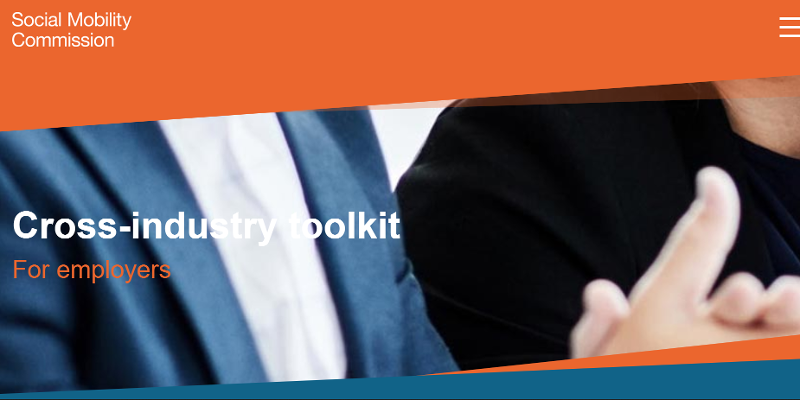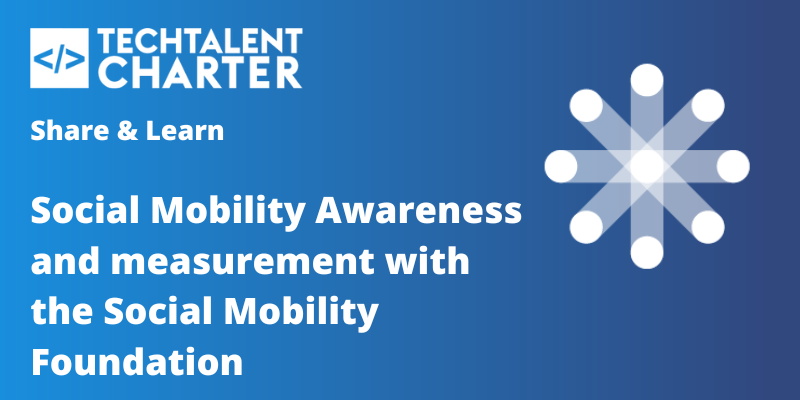Diversity in Tech
An annual report tracking diversity in technology across the UK
.gif)
Powered by:

Latest statistics and insights on diversity and inclusion in UK tech
The Tech Talent Charter is a not-for-profit that fights for better diversity and inclusion in tech. In today's climate of social division, technological advancement and economic strain, our efforts to create a fair and equitable society are under threat.
Through our annual survey of over 700 UK Signatory organisations, we can lift the lid on the latest diversity and inclusion practices, and highlight where inequalities require dire and urgent action. By serving these insights back to the public for free, we enable organisations to learn from each other and work collectively to improve diversity and inclusion in tech.
Introduction
Diversity and inclusion in tech is facing a defunding crisis. Three years ago, companies were staunchly pledging to improve equality, posting black squares on their social media and proclaiming their action plans for improving D&I. Fast-forward to today and the message is very different.
D&I strategies are becoming increasingly insular, initiatives are being shelved to prioritise other business goals, and more and more we hear that ‘D&I isn’t relevant because my company isn’t hiring’. Alongside this are countless stories from D&I role-holders and advocates who are battling for support from senior leaders as their teams are decimated, their processes eliminated by mergers and acquisitions or being forced to step back from voluntary efforts due to changing business attitudes and overburdened desks.
In this report we give you the stats on diversity and inclusion in tech, with updates on women in tech, gender diversity, and ethnic diversity as well as some new data points on socio-economic diversity, neurodivergence and disability in tech. But we also want to share a warning that painstakingly-won D&I progress is at risk of being lost, and if we continue with the current trajectory it’s going to get worse.
The path to progress is clearly marked. Our report and other free resources are available to support any company - irrespective of budget - to improve D&I. What we need is for business leaders to commit to sustained, intentional effort that shows they are serious about diversity and inclusion, not for the optics, but because they truly care about people and they know that D&I has a powerful impact on the productivity, competitiveness and resilience of their business.
Thank you to all of our Signatories who shared data with us to produce this report. As long as you’re committed to improving diversity and inclusion in tech, we’re alongside you.
10 key statistics about diversity in tech in the UK






















10 key statistics on diversity in UK tech
▶️ 29% of UK tech employees are women or non-binary.
▶️ 20% of software engineers are women or non-binary.
▶️ 21% of senior tech role holders are women.
▶️ 25% of UK tech employees are ethnic minorities; 5% are Black.
▶️ 22% of software engineers are ethnic minorities.
▶️ 14% of senior tech role holders are ethnic minorities.
▶️ 0.17% of tech employees identified as trans compared to 0.5% of the UK 16+ population, but only 1 in 4 companies are measuring trans identity in their workforce.
▶️ Just 3% of tech employees have disclosed they are neurodivergent whilst UK estimates for neurodivergence are 15-20%.
▶️ Only 9% of tech employees are reported to be from lower socioeconomic backgrounds. This compares to 39% of the UK population.
▶️ 6% of tech employees are disabled compared to 23% of the wider working age population.
Explore the latest diversity in tech insights
Click on any of the themes to navigate to that section in the report.
Diversity in UK Tech
The data in this report comes from the Tech Talent Charter's annual diversity in tech survey of 708 organisations in the UK, employing close to 977,000 people. Our diversity in tech statistics are based on a total sample of close to 230,000 UK tech employees. The data was collected between July and October 2023.
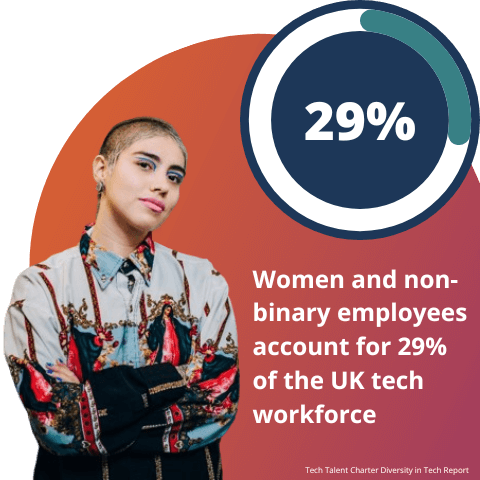
29% of tech employees are women or non-binary
Creeping up to 29%, this is the highest proportion of women and gender minorities in tech recorded since Tech Talent Charter started collating tech diversity data. Employers reported only a tiny proportion of non-binary tech employees so the 29% figure essentially reflects the number of women in tech. This figure is higher than the UK tech industry average and suggests that amongst our Signatories - companies that are working to improve diversity - better tech workforce diversity is achievable, irrespective of company size, sector or location. This progress bucks an overall trend in the UK where the number of women in tech is decreasing, according to ONS data.
But the future outlook for gender diversity in tech is bleak
For many, the slow gains feel like a poor victory when other UK gender equality measures like pay equity, diversity in senior positions, and retention rates, are challenged. So whilst we can acknowledge progress has been made, we also must recognise that it is dwarfed by the outstanding obstacles. In our research we found that 1 in 3 women in tech are already planning to leave their job. On top of this, if companies are discarding their D&I work, gender diversity in tech will be set up for decline. All the while reports highlight that the gender pay differences are worsening, and BCS warned that it will take 300 years to close the gender pay gap in tech. Now more than ever, we need to double down on gender diversity in tech if we are going to do more than make slow and fragile progress.
“Global is committed to enhancing opportunities for women in technology to encourage diversity of thought, increase our output and expand the talent pool. Our 'Women in Technology' initiative provides mentorship, networking, and sponsorship to support the career advancement of women in our technology, data, and digital functions. We've implemented training to address unconscious bias and inclusive interviewing and are tracking gender metrics to promote fair recruitment practices. Additionally, our Global Academy school offers Digital & Technology T-Levels for 16-18-year-olds, with a focus on encouraging female STEM students to enroll."

David Henderson,
Chief Technology & Product Officer
at Global
"It’s absolutely key that we collaborate within and across industries to encourage more women into careers in technology. We can start by building a strong youth career strategy and then support those who want to consider diversifying their career by creating upskilling and reskilling pathways. We also need to champion and foster inclusive environments where women want to stay and grow in their careers. At Lloyds Banking Group, we’ve learnt that strengthening gender diversity in technology roles requires a long-term focus alongside short-term actions, underpinned by visible commitment from the top."

Sarah Underhill,
People Director, Group Chief Operating Office
at Lloyds Banking Group
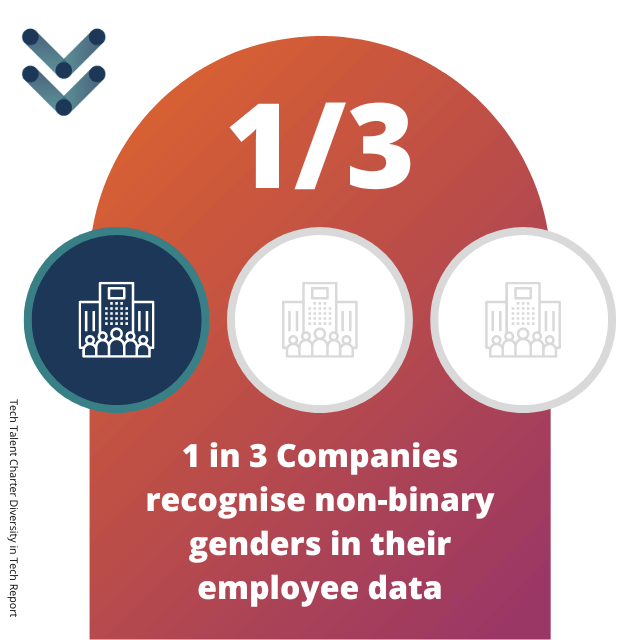
Only one third of companies recognise non-binary genders in their employee data
Only 0.09% of tech employees are reported to be non-binary, based on a sample of 89,000 tech employees at 235 organisations that recognise non-binary genders. Failure to recognise more than two genders in your company infrastructure is becoming an increasingly exposing way of signalling that non-binary folks in your organisation are, quite literally, not to be counted.
Whilst companies can struggle to operationalize LGBTQ+ data collection due to differences in regional legislation and software system inflexibility, we still need to find ways to support these colleagues at work. It’s easy to think that discrimination against the LGBTQ+ community is something that happens in other parts of the world, but the past year has seen a significant increase in the reported number of hate crimes against these groups compared to previous years. It’s therefore important to adapt organisational policies and processes where possible to include a fuller spectrum of gender identities. Beyond simply asking the question, employers must make workplaces feel safe, or colleagues will not want to disclose this information when it’s requested.
Trans representation in tech is only a fifth of the national average at 0.17%
For the first time Tech Talent Charter asked organisations about trans identity amongst their tech workforce, and found that only 26% of companies are enabling their employees to disclose being trans in their diversity data processes. Those that do, employ close to 70,000 tech workers; 0.17% of them identify as trans, compared to 0.5% of the working-age UK population. Because of the historic shortage of data representing the LGBTQ+ community in tech, it's hard to draw conclusions from these figures. But the one thing we can say is: we need to do more to understand why these numbers are lower than UK figures. Are trans folks underrepresented in tech, unrecognised in employer data, or simply unable to trust employers with disclosing this information?

8 things you can do to support gender and LGBTQ+ inclusion
1. Measure transgender and non-binary gender diversity, not just men/women.
2. Offer the option to use the gender-neutral titles like “Mx” in business systems.
3. Provide healthcare benefits to support employees who are transitioning.
4. Invest in “Pride allies”, who are trained, informed and have responsibility for being visible and vocal advocates for LGBTQ+ inclusion within the business.
5. Mark moments of awareness such as International Day Against Homophobia, Transphobia and Biphobia.
6. Adapt the language and content of family policies to be inclusive of same-sex couples.
7. Have a gender expression and transition policy.
8. Gender-neutral and accessible toilets.
Ethnic diversity
in UK Tech
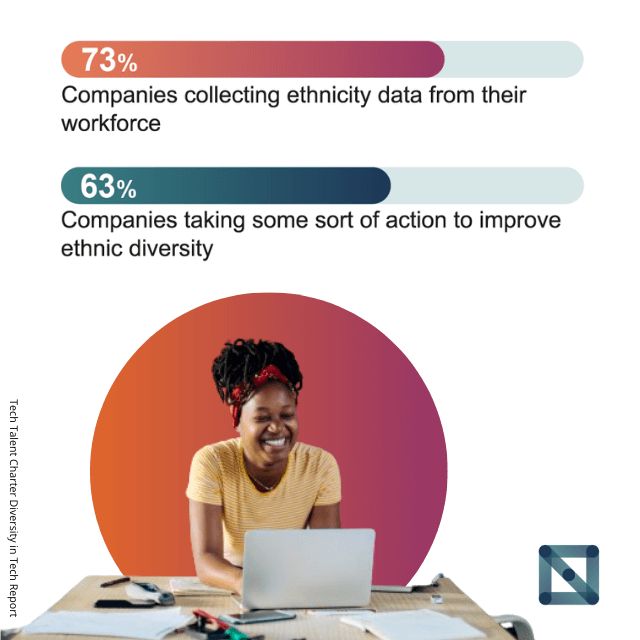
One quarter of tech employees are ethnic minorities
Based on ethnicity data shared by over 140,000 tech employees, there is a relatively high proportion of ethnic minority representation in tech compared to the UK workforce overall. However, this doesn’t tell the whole story because the tech ecosystem is skewed towards London, which has higher ethnic diversity, meaning that the benchmark for ethnic diversity in tech should be higher than the national average.
Efforts to improve racial and ethnic diversity feature prominently in Signatory D&I efforts. Ethnic diversity is the second most-focused on area of D&I after gender. 73% of companies are collecting ethnicity data from their workforce and 63% of companies are taking some sort of action to improve ethnic diversity.
.png)
Understanding regional diversity and using relevant data to inform your D&I efforts is a vital part of ensuring that D&I goals are realistic and meaningful.
That’s why we created our free D&I Benchmarking Calculator. Find out how your company compares to its regional counterparts.
Employees don't feel comfortable sharing ethnicity data
178,000 tech employees were asked about their ethnicity but more than one in five did not share this information with their employer. The average disclosure rate for ethnic diversity information remains at about 79%.
Disclosure rates are an important measure of inclusion, because they indicate the level of trust your employees have in your D&I efforts. If you are starting to collect new diversity data for the first time, include disclosure rate as one of your metrics of success.
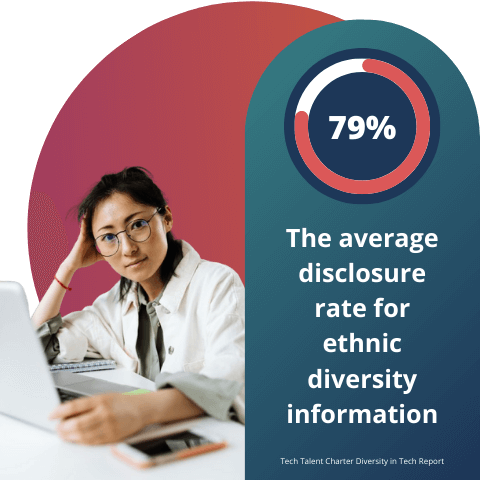

5% of tech employees are Black
Many organisations have initiatives or diversity goals that focus on Black inclusion, especially improving representation of Black tech workers in all parts of the talent pipeline. This can only be achieved if the diversity data being collected is disaggregated by distinct ethnicities, so that it enables employers to understand intersectional considerations and unique challenges certain ethnicities face.
“Research tells us that when products and services are designed inclusively by diverse teams, they will be more likely to better meet the needs of the customers and communities they serve.
Having diverse teams means we can create a culture that welcomes new ideas and different perspectives – shaping the future by those that create it.
We have a role to play to ensure that we use finance and tech as a force for good, and not reinforce the systemic inequality."

Ranil Boteju,
Chief Data & Analytics Officer
at Lloyds Banking Group
“We launched ‘My Self ID’ in 2021 where we invited our employees to privately and confidentially disclose their personal characteristics. The goals were to help us develop a more complete picture of the diversity of our existing workforce, target areas of improvement, ensure our ways of working supported everyone. In time, this type of activity will help us and other organisations understand whether we’re succeeding in supporting a more DE&I friendly industry.Greater diversity in our teams leads to richer thinking, increased collaboration, more creative problem solving and greater innovation. But without accurate data, we can’t tell if we’re doing the right things to support under-represented groups and attract diverse talent. Most importantly, we can’t tell if we’re improving. Encouraging our employees to tell us a bit more about who they are helps us paint a picture of who we are; and that will help us make meaningful change for the better. But as the latest stats show, comfortability is a huge part of encouraging employees to disclose such personal information. That’s why fostering trust and inclusivity as key corporate values is so important.”

Theresa Palmer,
Global Head of DE&I
at BAE Systems Digital Intelligence
"Research tells us that when products and services are designed inclusively by diverse teams, they will be more likely to better meet the needs of the customers and communities they serve. Having diverse teams means we can create a culture that welcomes new ideas and different perspectives – shaping the future by those that create it.
That’s why, at Lloyds Banking Group, we foster a safe environment for people to share their diversity data and help create inclusive outcomes. We have an important role to play to ensure that we use finance and tech as a force for good, and not reinforce the systemic inequality.”

Ranil Boteju,
Chief Data & Analytics Officer
at Lloyds Banking Group
“We launched ‘My Self ID’ in 2021 where we invited our employees to privately and confidentially disclose their personal characteristics. The goals were to help us develop a more complete picture of the diversity of our existing workforce, target areas of improvement, ensure our ways of working supported everyone. In time, this type of activity will help us and other organisations understand whether we’re succeeding in supporting a more DE&I friendly industry.Greater diversity in our teams leads to richer thinking, increased collaboration, more creative problem solving and greater innovation. But without accurate data, we can’t tell if we’re doing the right things to support under-represented groups and attract diverse talent. Most importantly, we can’t tell if we’re improving. Encouraging our employees to tell us a bit more about who they are helps us paint a picture of who we are; and that will help us make meaningful change for the better. But as the latest stats show, comfortability is a huge part of encouraging employees to disclose such personal information. That’s why fostering trust and inclusivity as key corporate values is so important.”

Theresa Palmer,
Global Head of DE&I
at BAE Systems Digital Intelligence
Ethnic diversity in VC and startups
The VC market in the UK is the largest in Europe, and plays a crucial role in driving innovation and economic growth. Equity-backed businesses in the UK support approximately 2.2 million jobs and contribute to 11% of the country's gross domestic product (GDP) (Taylor, 2023). However, this sector faces significant challenges regarding ethnic diversity.
Women make up 38% of the UK VC workforce, however only 3% of women from ethnic minority backgrounds hold senior positions in VC firms. There are no senior Black women holding any senior positions in VC firms as identified in a British Venture Capital Association (BVCA) survey.
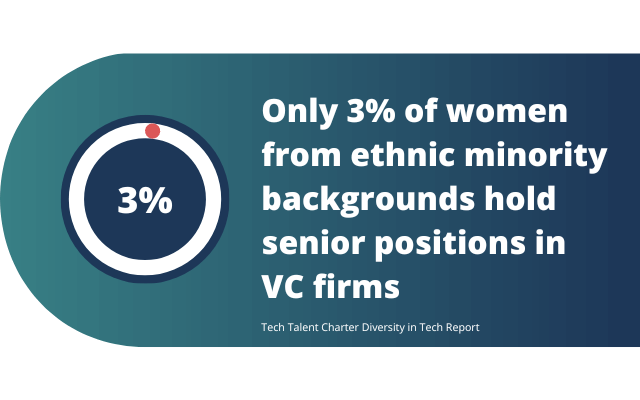
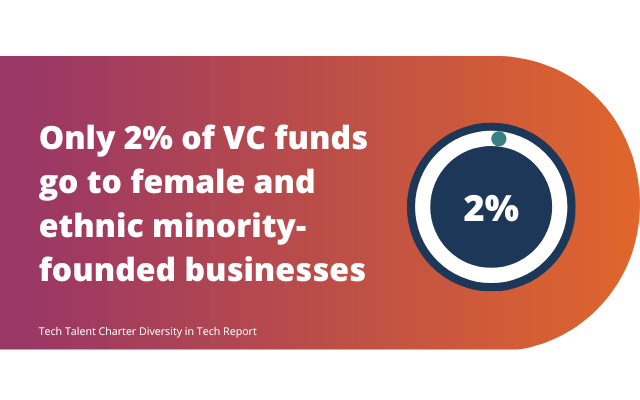
New rules on investing will damage D&I in the startup ecosystem
Only 2% of VC funds go to female and ethnic minority-founded businesses. This is magnified by the geographical concentration of investments, with 80% of VC funding concentrated in the “Golden Triangle” of London, Oxford, and Cambridge (Wood, 2023).
This lack of diversity in the VC and startup ecosystem comes at a significant cost. Morgan Stanley research indicates that VCs could miss out on up to $1 trillion in opportunities by not investing in women and minority-led businesses.
Unfortunately the picture is set to get worse: new legislation on the financial threshold for angel investing will see underrepresented groups pushed further out of the investor pool, and as a result, fewer minority-owned businesses are likely to receive funding as a result.
Update: shortly after this report was published the government reversed their decision to increase the income threshold for angel investment after industry outcry and lobbying. The Tech Talent Charter welcomes this decision and has supported the lobbying efforts that led to the change.
“In an environment where women still get <10% of VC Black led businesses get under 2% of share of funds, and over 80% of investors are men the data is stark, obvious, clear. We need more equity in the venture ecosystem to ensure regardless of your demographics, you have a fair shot at making the industry your place of work, and to ensure we are giving all founders a fair shot of scaling their businesses."

Ashleigh Ainsley,
Co-founder
at Colorintech.org
“The venture capital space must recognise the systemic challenges founders from underrepresented communities face to get their ideas heard. When underrepresented founders lack VC support, it reinforces the misconception that investing in them carries higher risks and subsequently diminishes funding opportunities even further. For instance, only 1.7% of all venture capital investments over the past decade went to all-ethnic-minority teams, despite ethnic minorities comprising 14% of the UK population (TechCrunch). Measurable objectives, accountability, and transparent data on current inequities are all necessary for us to drive lasting and meaningful change. An inclusive innovation economy that draws on all talent is only possible if stakeholders work collectively to break down existing barriers.”

Francesca Arese Lucini,
Head of Insights and Data
at Founders Forum Group
6 actions to support ethnic diversity and inclusion at work
1. Educate colleagues on how to speak about ethnicity and race at work, to help employees develop greater confidence and capability to engage in discussions on these topics.
2. Be explicit about the practical expectations of employees in your policies to ensure that cultural differences in interpretation and need do not create unfair barriers for minority groups.
3. Establish collaborative links between different diversity networks in your organisation to help support intersectional lenses of diversity, for example partnerships between ethnicity-focussed networks and networks for gender, LGBTQ+ and Disability/Health.
4. Define an inclusive dress code policy that protects afro-textured hair and hairstyles linked to cultural, ethnic and racial identities.
5. Provide emotional, wellbeing and practical support for colleagues affected by ethnicity or race-related world events e.g. violence in the Middle East or Covid-related racism.
6. Set targets for: junior hires from diverse ethnic backgrounds, promotion rates of ethnic minority employees, and ethnic representation in senior and leadership roles.
Diversity in senior tech roles
Companies are focusing heavily on diversity in senior positions. The top three most common D&I data points companies are measuring are to do with diversity in the workforce, talent pipeline, and employee experience scores, but the next four most common data points are those focused on seniority, progression and retention.
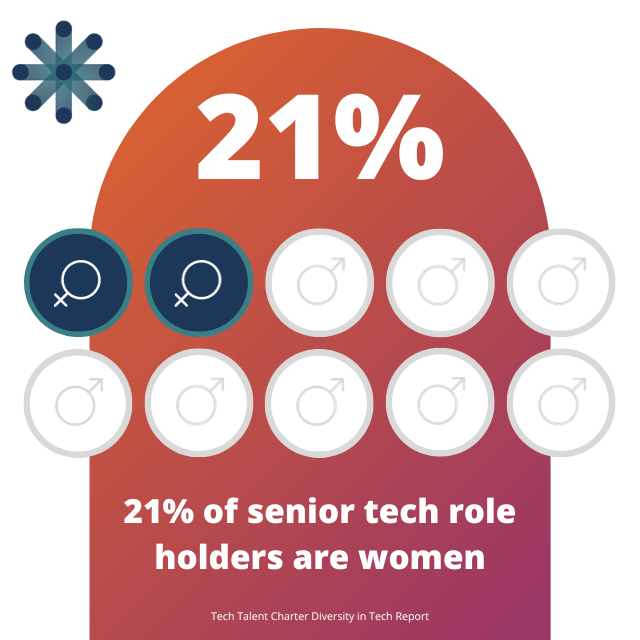
Gender diversity in senior tech positions backslides to 21% as companies focus on shoring up progression and retention for women in tech
Based on a sample of nearly 9,000 senior tech role holders, 21% are gender minorities - an eight percentage point gap to gender diversity in tech overall (29%). Since last year the gap has grown by one point, reflecting an increase in the number of gender minorities in tech overall but also a fall in the proportion who hold senior roles. The fall comes amidst continuing reports of the barriers women face to access top positions.
Attrition of women in tech: why women are leaving tech jobs
When a tougher economic climate makes companies scale back on hiring, it forces attention onto what happens to diverse talent already in the business. Unfortunately, for many underrepresented groups, getting into a company doesn’t mean you’re going to get on within that company. The TTC conducted research among women in tech and found that a shocking one in three were planning to leave their tech job. Of these women, a quarter planned to find work in another sector.
Equitable compensation is a key factor for retaining women in tech. It was ranked as the second most important factor in women’s decisions to leave a tech job. A concern levied against employers is that pay processes fail to recognise “non-promotable tasks”. Women reportedly undertake more of these tasks, resulting in better productivity for the team, but receive no reward for enabling it. Women also linked their salary dissatisfaction to the mental load associated with caring commitments and the societal expectation for their earnings to cover the spiralling cost of childcare during a cost of living crisis. This highlights the need for employers to deepen their understanding about parenthood inclusion at work.
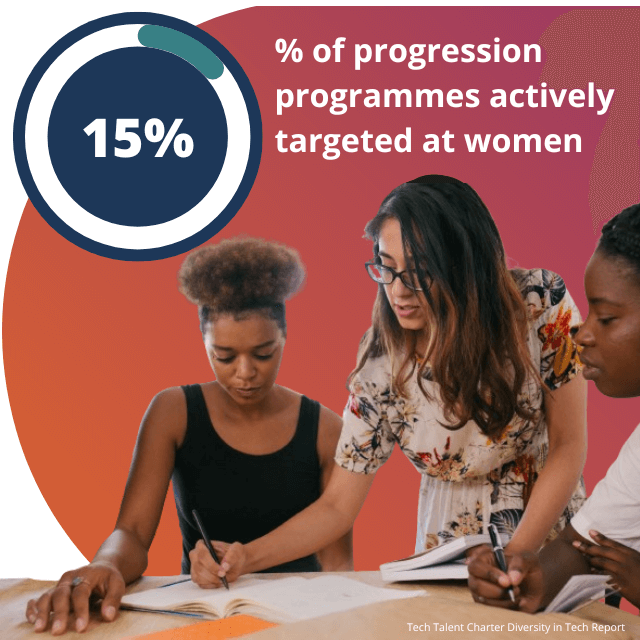
80% of women say dissatisfaction with career progression was a factor in them leaving their tech role
Understanding retention and progression drivers are critical to improving diversity in tech and some organisations are doubling down on their efforts to progress diverse talent. 245 Signatories are implementing some sort of skill or progression programme for their employees. However, just 15% of them are targeted specifically at women. This is important because four out of five women in tech report that dissatisfaction with their career progression was a factor in their decision to leave their tech role. If we’re not creating transparent and equitable opportunities for advancement, employers must expect women will leave.
Why women leave tech jobs - 8 key stats
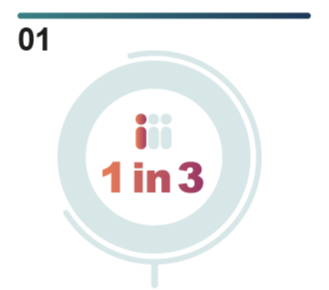
One in three women are planning to leave their tech job.
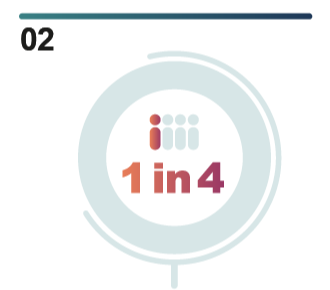
One in four women who left a tech job in the last few years left for a non-tech job.
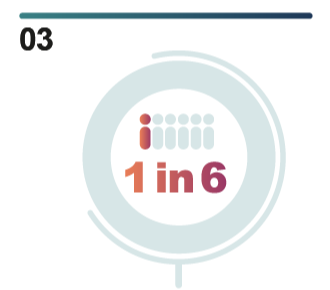
Only one in six women who have been in their tech role for more than a year are planning to stay.

Four out of five women said that dissatisfaction with their career development impacted their decision to leave their tech role.
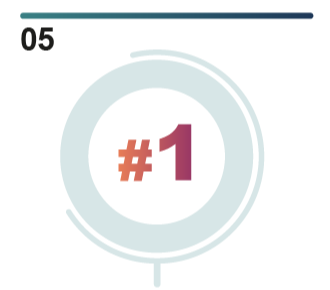
Work-life balance was ranked the most important factor in women's decisions to leave their tech role, often linked to challenges managing caring commitments.
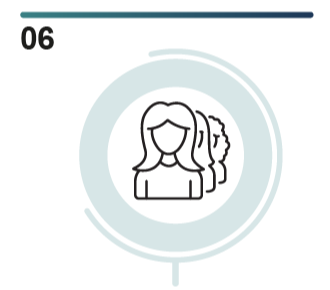
Women in tech with flexible work arrangements had significantly higher retention.
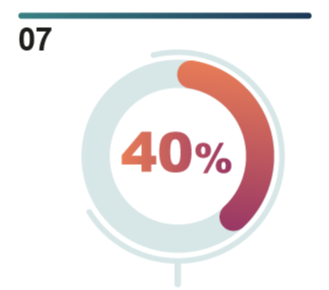
Nearly 40% of women agreed that caring commitments influenced their decision to leave their tech job, but only 11.4% of them actually left the workforce to do this.
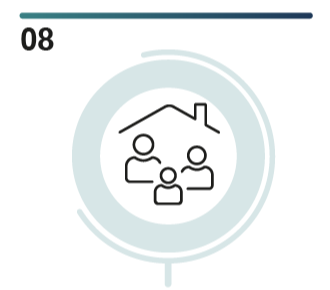
Pay dissatisfaction is one of the top factors motivating women to move jobs, and was often linked to the cost of living crisis and childcare high costs.
“Losing talented women in tech - and brilliant role models for greater diversity and inclusion in tech overall - is not just a setback for gender diversity; it's a missed opportunity for innovation. Teams that fail to reflect the diversity of their users, will fail to create products that those target users value. In other words, lack of diversity severely limits the breadth of your product’s relevance, and limits your global opportunity. The tech world must address the root causes, providing an inclusive and supportive environment where diversity - including women in tech - can thrive, ensuring our industry and our products benefit from the most representative spectrum of talent.”

Jeremy King,
CEO
at Attest
“We want to create environments where women are visible, valued, and have support to accelerate their technology careers. Retaining gender diverse talent pan-industry will help us ensure together that tech teams and their products can reflect the society they serve. Technology leaders must actively look deeply into what influences those choices to stay or leave and relentlessly tackle systemic conditions to create inclusive environments where women want to stay."

Karen Rossi,
CIO for Corporate & Institutional Banking, Finance & Payments
at Lloyds Banking Group
Ethnic diversity drops to 14% in senior tech roles compared with 25% overall
Ethnic diversity in senior tech roles is not improving and remains poor. Representation drops from one in four, to fewer than one in six in the senior roles. This is in spite of ethnic minority IT workers being more likely to hold higher education qualifications than their White counterparts (87% versus 67%). Coupled with a shrinking number of senior tech role holders, and reports of tech layoffs disproportionately affecting ethnic minorities, the ethnic minority population we do have is at risk of becoming smaller.
Ethnic diversity in top roles drops more sharply than gender diversity does (11 point drop versus 8 point drop respectively). Whilst lower gender diversity in senior roles is partially explained by women assuming a higher proportion of caring responsibilities, the drop in ethnic diversity can’t be explained by a similar practicality, and highlights very troubling questions as to why this is the case.
23% of the companies who shared their goal for ethnic diversity had a measure related to ethnic diversity in leadership, making this the second most common type of diversity KPI when it comes to ethnic diversity, after overall ethnic diversity in the workforce. Yet just 13% of the 245 progression programmes being run by employers are specifically targeted at improving ethnic diversity. Unless organisations create career development architecture that supports ethnic minorities to move into more senior roles and addresses points of failure in the talent pipeline, meaningful change is unlikely.
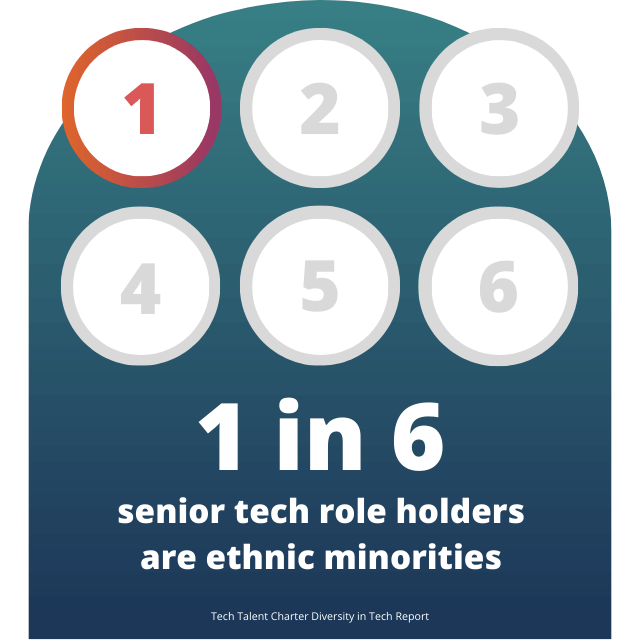
"Black and minoritised women have experienced additional levels of exclusion, with almost three in four having experienced racism at work."
"1 in 3 Black women have been assumed by colleagues to not hold a technical role."
From 'System Update: Addressing the Gender Gap in Tech' by The Fawcett Society
Top 5 diversity and inclusion goals and KPIs: how companies are assessing their success
We asked Signatories what goals they had set for their D&I work. Here is what companies reported having as their KPIs for D&I, by order of frequency.
1. Representation within the workforce
2. Diverse representation in leadership
3. Diversity of talent in the recruitment funnel
4. Employee experience scores and measures
5. Level of diversity data disclosure/completion
Diversity in software engineering
Tech roles include a wide range of jobs but one job family draws particular interest from employers because of the skills it requires: software engineering. Software engineering has some of the most well-remunerated roles in the tech industry. The economic benefits of the tech economy are most concentrated for these in-demand role holders, so we asked organisations about the diversity amongst their software engineers, to understand who’s in this powerful group.
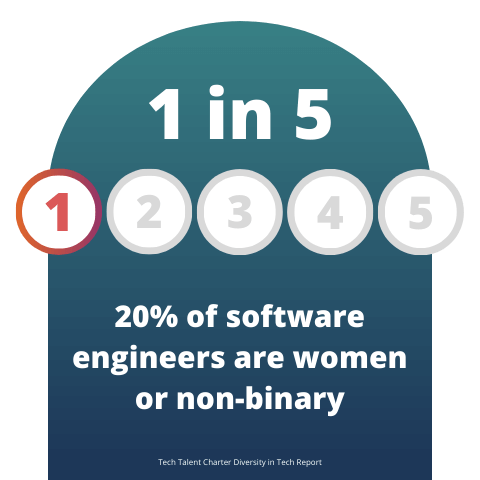
Only one in five software engineers are women or non-binary
From a sample of nearly 32,000 software engineers, 80% were reported to be men. The proportion of women in software engineering compared to tech roles overall (for example roles in data, product, IT, design, testing etc) drops by about a third, from 29% across all tech roles, to 20% in software engineering. As tech advancements accelerate, we need to ensure that diverse groups are involved in the creation of AI tools and other technologies that run our society, or we risk codifying inequities into our digital infrastructure.
22% of software engineers are ethnic minorities
We also found that ethnic minority representation amongst software engineers was lower than amongst tech employees overall, dropping from 25% (all tech employees) to 22% (software engineering roles).
Failing to consider diversity in software engineering means we miss an opportunity to address a deeper imbalance: whilst the tech workforce may be becoming more diverse overall, the most prestigious and highly-paid roles are still predominantly held by one group. Pay gap reports will continue to highlight a diversity problem in tech until we take these factors into consideration.
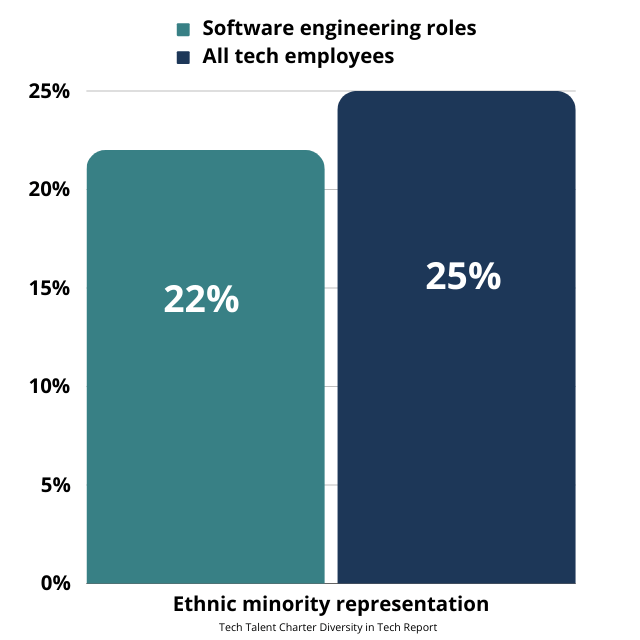
“Software engineers have a huge influence on the wider culture in the tech industry. A software engineer is usually one the earliest hires new tech startups will make. Early hires set the culture in a new business, and these startups set the culture of the UKs tech ecosystem. It’s no wonder that the tech industry faces criticism for exclusionary “brogrammer” culture, when the people who influence tech company culture the most are often the least diverse.”

Lexie Papaspyrou,
Product Director
at Tech Talent Charter
“Diversity in software engineering is not just about fairness, it’s about fuelling innovation. At Sky, we recognise that when diverse teams collaborate, the possibilities for tech advancement are limitless and exciting. This is why we engage with our programmes like LIFT as we Climb which takes a holistic approach to supporting women in technology, their advancement and growth. Our bespoke mentoring programme supports diverse colleagues in developing their knowledge and broadening their experience.”

Dianne Cavanagh,
Director of Software Engineering
at Sky
More ways to increase diversity in software engineering

Tech Talent Charter's
D&I Open Playbook on reskilling or retraining talent into tech roles
Top 10 D&I metrics: what diversity data are companies measuring?
Progress starts with measurement. We asked Signatories what data they were looking at to understand their D&I efforts. Here is what companies reported measuring internally, by order of frequency, to understand D&I in their organisation.
1. Representation within the workforce
2. Employee experience scores and measures
3. Diversity of talent in the recruitment funnel
4. Pay gap
5. Leadership representation
6. Retention
7. Progression
8. Participation in D&I training or events
9. External awards or rankings
10. Disclosure rates or completion rates of diversity data
Socio-economic diversity in tech
In the past year, we have raised awareness of the importance of socio-economic diversity in tech. The Bridge Group previously reported that the demographic makeup of the tech industry is far more elite than we might like to think, being comparable to professions like journalism. Economic and social opportunity plays a huge role in whether or not people are able to access the opportunities the tech economy has to offer. For the first time, we are able to shed some light on what the socio-economic makeup of the UK tech industry actually is.

Only 9% of tech employees are reported to be from lower socio-economic backgrounds compared to 29% in finance and 23% in law
Gathering data on over 30,000 tech employees from 85 different employers, we found that tech does indeed appear to have some serious problems with socio-economic exclusion, faring far worse than sectors that have long been chastised for elitism. This data reflects those who disclosed to their employer about their socio-economic background so the true number may be higher. The point is though, we need to be better at measuring and understanding the role tech employers play in the social mobility of the country, and it needs to start with far more organisations educating themselves about how to measure and understand social mobility and why it’s important.
Some employers express reluctance to ask about socio-economic background because the questions used to measure it can feel awkward or not relevant to some employees, for example those educated in other countries or those in certain age groups for whom some questions may not feel relevant. However, there are robust frameworks in place to help.

"Getting involved with the Tech sector is a powerful vehicle for social mobility. Recognised for its propensity for change and innovation, it can provide many opportunities for people from all backgrounds. With only 9% of tech workers in industry coming from lower socio-economic backgrounds, Sky is committed to providing upskilling and reskilling opportunities to get into tech from all parts of our organisation. Our award-winning Get into Tech programme has been instrumental in supporting women from all backgrounds developing foundational skills in technology, to kickstart a new career. Tech can break down barriers, gather diverse ideas and empower people to significantly enhance their living standards."
SACHIN JOGIA
Group Director for Transformation and Technology Strategy at Sky
Three key resources for measuring social mobility in your workforce

The Social Mobility Foundation guide to calculating your socio-economic diversity pay gap

Top 10 D&I resources organisations most commonly use
We asked our Signatories which resources they used to help inform their D&I practice. The top ten resources they referred to by order of frequency were:
1. Tech Talent Charter
2. CIPD
3. Stonewall
4. Business in the Community
5. Business Disability Forum
6. Disability Confident
7. Inclusive Employers
8. Race at Work [Charter]
9. McKinsey D&I insights
10. Census data
Disability in Tech
According to ONS, 23% of the wider UK workforce are disabled. There is a strong business case for why organisations should endeavour to be disability inclusive: they are a source of untapped talent; they reflect a significant group in the general population; and making adjustments to include them is typically extremely low-cost and straightforward. These factors, combined with the prevalence of flexible working and ever-improving assistive technology, make the tech sector a natural home for many disabled workers with digital skills. However, recent research by Jefferson Frank revealed that 63% of disabled tech workers face qualification barriers, underlining the importance of inclusive hiring practices.
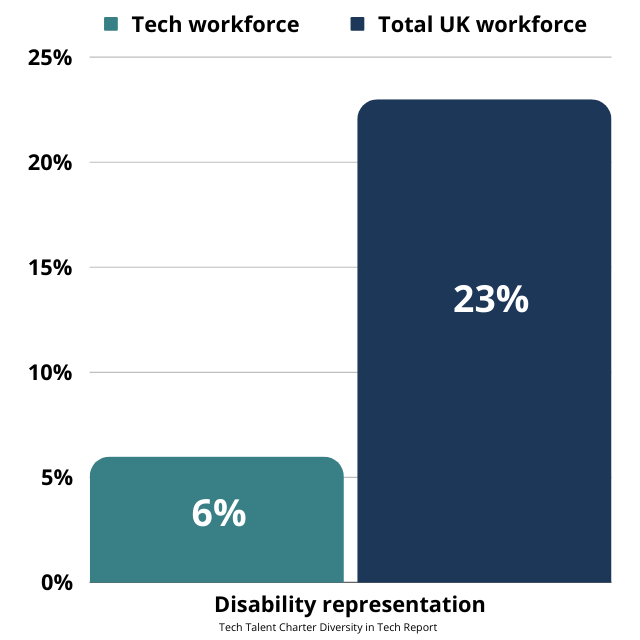
Just 6% of tech employees are disabled despite making up 23% of the UK workforce
We asked organisations to tell us about disability in their tech workforce. Based on a sample of over 113,000 tech employees, just 6% of tech employees are disabled. The majority of people will at some point be directly or indirectly affected by disability, whether persistent, transient or caring-related. It is a commercial and moral imperative for companies to remove disabling barriers in work environment and culture so that disabled people can access engaging and meaningful careers in tech.
Inclusive hiring practices are vital for the fair treatment of disabled people. A persistent but all too common example is that it could take a disabled person longer to obtain a certain type of qualification. If a company has age expectations - whether implied or explicit - on employment programmes or jobs, disabled people are unfairly blocked from vital economic opportunities as a result.
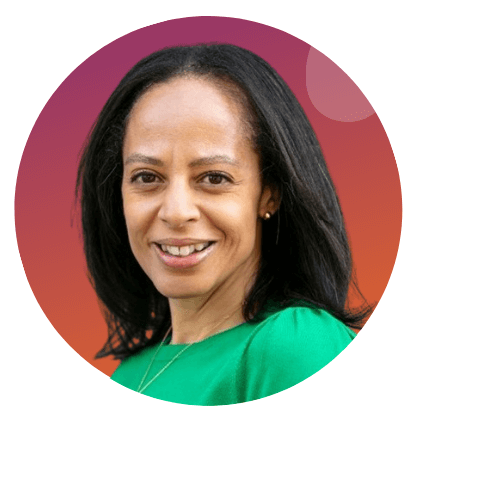
"It’s critical that organisations challenge themselves to build an inclusive and accessible working environment, which reflects our modern society. We know there is more to do to ensure people with disabilities are represented in tech. This is why at LBG we were the first UK bank to set a goal to double the representation of colleagues with disabilities at senior management levels, to 12% by 2025."
RACHEL OSIKOYA
Diversity, Equity and Inclusion Director at Lloyds Banking Group
5 ways to support disabled employees at work
1. Consider how disability affects employees throughout their career journey, not just when they are hired.
2. Give people regular opportunities to disclose and discuss disabilities and conduct listening exercises to understand how disabled people wish to be supported, rather than assuming what their needs are.
3. Ask people whether they identify as disabled, their preferred language to self-describe, and the adjustments they need for their productivity, progression and inclusion in the company culture.
4. Frame conversations in terms of disabled colleagues’ achievements and strengths. A small number of companies have reported running leadership development programmes specifically tailored for disabled employees.
5. Finally, be clear on your legal responsibilities for supporting disabled people.
Want to know more about the disability practises, partners and resources other organisations are using?
Neurodiversity
in Tech
We asked Signatories if they could share neurodiversity data with us on their tech employee base. 21% (151 organisations) provided data, giving a total sample of 60,000 employees. Based on this group, just 3% of tech employees are reported to be neurodivergent. Since this is significantly lower than the UK estimates of 15-20% (according to Deloitte), we partnered with Attest to conduct further research among UK tech workers themselves - and the results are thought-provoking.
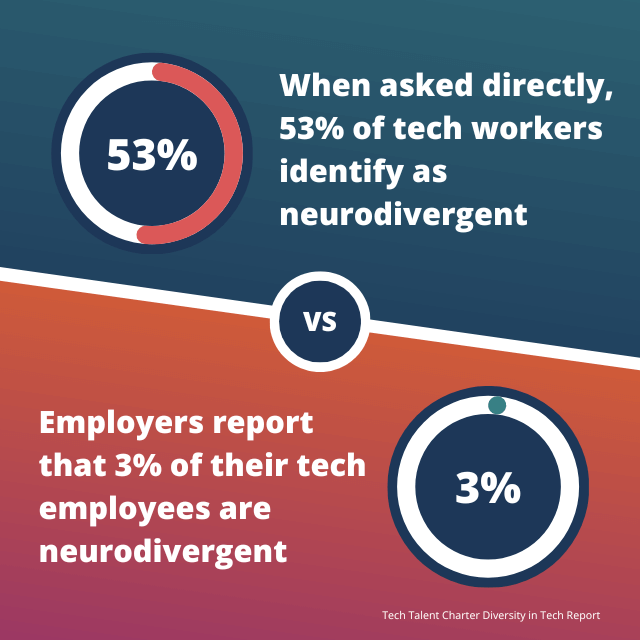
More than half of UK tech workers identify as being neurodivergent
The research we carried out among a representative sample of 500 UK tech workers found that 53% of respondents identify as having a neurodivergent condition (whether officially diagnosed or not).
The most prevalent conditions are autism/autism spectrum disorder (15%), ADHD/ADD (15%), and dyslexia, dyscalculia and dyspraxia (9%). Other conditions include cognitive functioning difficulties (6%), Tourettes (4%), and learning differences (3%).
Employer interest in neurodiversity is surging
Signatory awareness of neurodiversity has increased dramatically in the last couple of years, with the number of Signatories measuring neurodivergence in their workforce increasing from 26% in 2021 to 68% today (this puts neurodiversity efforts in fourth place behind gender, ethnicity and disability, tied with LGBTQ+ efforts in terms of how widespread they are amongst employers).
However, the gulf between the employer-reported neurodiversity rates and the tech worker-reported rates highlights the need for clearer discussion about what neurodiversity is, how neurodivergent people want to discuss and disclose this information, and how it should be supported in a work context.
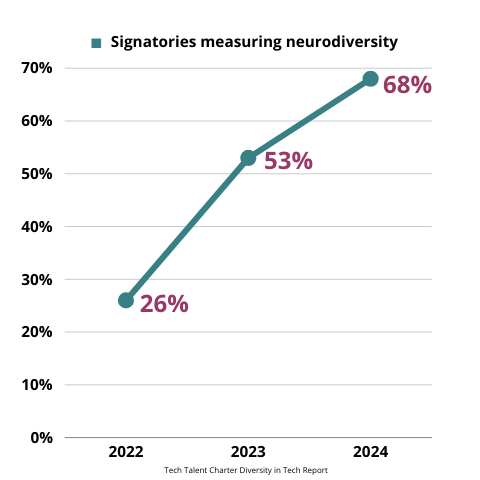
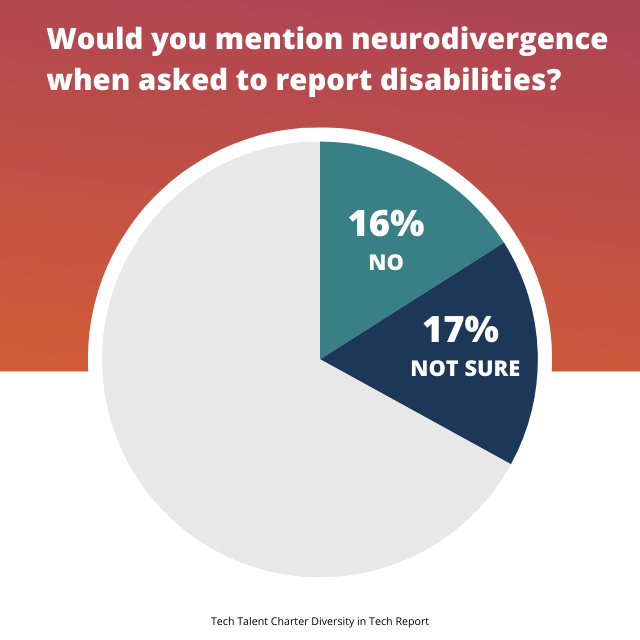
Neurodiversity is not always regarded as a disability by employees
Employers might expect employees and prospective employees to include details of neurodivergence when asked about disabilities, but this is not reliable. Although the law includes neurodivergence as a protected disability, just over 16% of respondents told us that they would not mention neurodivergence when asked to report disabilities, while a further 17% weren’t sure if they would.
This shows the need for employers to carefully word questions when attempting to collect data around neurodivergence. Only 63% of people in tech roles say their employer has explicitly asked if they have a neurodivergent condition, despite the fact that neurodivergence is protected under disability legislation.
If they have been asked, it’s most likely to have been as part of the job application (19%) or as part of a diversity & inclusion survey (16%). A further 15% have been asked about neurodiversity when onboarding, and 13% through the workplace HR system.

"Whilst it's great that awareness of neurodivergence is rising amongst employers, it's important for businesses to realise that awareness alone does very little to improve inclusion for neurodivergent employees. What makes a difference is the provision of meaningful, needs-led support at a policy level, and an informed and inclusive approach at a managerial level."
KAREN BLAKE
Co-CEO at Tech Talent Charter
Managers are not always aware of neurodivergent direct reports
While employees might not wish for details of a neurodivergent condition to be widely shared, if managers are unaware, they’re unable to provide any accommodations, meaning that employees may miss out on reasonable adjustments or Access to Work support. However, out of the respondents in our survey who identify as neurodivergent, only 62% say their manager is aware. The issue is more pronounced among female tech workers, 50% of whom have made their managers aware of their condition, versus 69% of males.
Neurodivergent employees could also benefit from greater awareness among colleagues. Less than half of respondents (45%) say their close colleagues are aware of their condition and only 20% say wider colleagues are aware. Respondents aged 55+, presumably in more senior roles, over-index for making teammates aware (68% close colleagues and 44% wider colleagues). Meanwhile, young employees (aged 18-24) are significantly more likely to share details of their condition with other neurodivergent colleagues (33%).

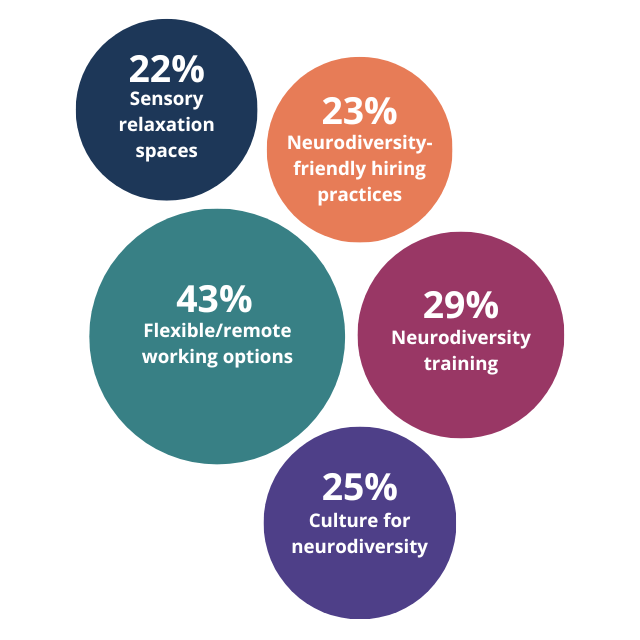
Working environments are not optimised for neurodivergent employees
While employers are making improvements in measuring neurodiversity they’re not necessarily taking action to make their workplace more inclusive. Only 22% of respondents say their offices have sensory relaxation spaces, while 29% have been offered training to support neurodiverse colleagues. And just 25% believe their company has a culture that celebrates neurodiversity.
A quarter of respondents say their employer offers a neurodiversity-inclusive approach to career development initiatives and training, but fewer (23%) say their employer has neurodiversity-friendly hiring practices.
In terms of benefits, a quarter of respondents say their employer provides health insurance that includes private diagnosis of neurodiversity conditions. Flexible/remote working is more widespread, available to 43% of respondents.
Despite relatively low adoption of initiatives to support neurodivergent workers, perception of employers’ inclusion efforts is fairly high. Nearly 69% of all respondents agree their employers do enough to support neurodiversity. However, this data shows that it wouldn’t take huge investment to make improvements that exceed employees’ expectations and boost employer branding.
5 neurodiversity barriers your company doesn’t know it has and how to fix them
Neurodivergent individuals can have the same neurotype but different experiences and support needs. Great neurodiversity practice is about creating flexibility for highly individualised, needs-led support without requiring formal diagnoses or standardised adjustments. If you want to make your workplace more neurodiversity-friendly, here are five problems your organisation probably has, that you can fix to support neurodivergent employees.
1. Stop making neurodivergent employees repeatedly “come out” at work. Put systems in place so that neurodivergent employees’ needs and adjustments are recorded, updated and can be discreetly shared with a new line manager. Some employers create ‘employee passports’ which do this job.
2. Educate your workforce on what neurodiversity is and is not, and challenge incorrect stereotypes. Being neurodivergent does not equate to having an intellectual disability and neurodivergent people should not be expected to ‘present’ in a specific way in order to be acknowledged. Make it clear to employees what neurodiversity is and how to get advice on it.
3. Tackle disrespectful behaviour towards neurodiversity support aids. Do any colleagues have apparently random toys on their desk? They may look like a bit of fun for anyone to handle but they could be sensory aids. Treat them the same way you would treat a wheelchair or walking stick: don’t touch them.
4. Recognise that agile working costs some more than others. Work stations for neurodivergent people can require more work to set up, for example colour overlays on screens. Be considerate of this when requiring employees to change their work location, e.g. hybrid and hot-desking. Employee productivity and safety are at risk if they find their workstation adjustments have been removed every time they return to the office.
5. Ensure that information relating to neurodivergence in your organisation is flowing clearly between HR, line managers and employees. Set clear expectations for how this information should be shared through the business. Make sure employees know how to access support, whether via line manager, HR, or through self-service access to resources.
Want to know more about the neurodiversity practises, partners and resources other organisations are using?
Closing statement from industry
by BAE Systems Digital Intelligence
Understanding our employees, driving DE&I and providing accessible learning to upskill and future proof our teams are more critical than ever in attracting, retaining and developing talent in the face of the ongoing digital skills gap. According to our research, 97% of decision-makers within critical industries admit a shortage of talent is hindering their ability to gain a digital advantage.
But it’s not just about our current people. Investing in the next generation of talent and ensuring the inclusion of all is also vital to the future of us as an organisation and the industry as a whole.
Greater diversity in our teams leads to richer thinking, increased collaboration, more creative problem solving, greater innovation, and ultimately the success of our business. But without accurate data, we can’t tell if we’re doing the right things to support under-represented groups and attract diverse talent. Most importantly, we can’t tell if we’re improving. Understanding who our employees are through ongoing confidential ‘Self ID’ reporting helps us to paint a picture of who we are; and that will help us make meaningful change for the better. But as Tech Talent Charters’ stats show, comfortability is a huge part of encouraging employees to disclose such personal information. That’s why trust and inclusivity must be a big part of our corporate values across the industry.
Gaining insights into employees’ personal characteristics through confidential reporting has helped us at BAE Systems Digital Intelligence to develop a more complete picture of the diversity of our workforce today, identify target areas of improvement and ensure our ways of working support everyone. In time, it will allow us to demonstrate whether we’re succeeding in becoming a more DE&I friendly employer.


Diversity and inclusion in tech has come as far as it can in the hands of advocates and allies. If you want to see change now, the rest is up to you.
A call for change
This report arms you with the diversity and inclusion facts, strategies and insights you need to improve D&I in tech. The examples from organisations included in it are testament to what is possible. However, the report is also here to forewarn you about concerning changes in the wider market.
Progress comes from intentional, sustained and well-resourced effort. But when accountability fades, D&I activities become performative, superficial “support-washing”, where companies say what they need to look good, rather than taking the action needed to be good.
Lots is possible. The solutions are known. What is missing is the intention, funding and leadership commitment to making sustainable and meaningful change. Market tides are turning away from D&I despite the many powerful and enduring business cases in its favour. So if we are going to eradicate some of these issues, we have to do it now before the window of opportunity narrows even further.
We cannot leave D&I work on the side of someone’s desk and expect that it will happen alongside their day job. It also cannot be the responsibility of those in minority groups, who should be supported by these efforts rather than saddled with them, because nobody else cares enough to make it a priority. D&I advocates in your business are tired of assuming responsibility for a business critical area, whilst being denied leadership buy-in, resourcing or reward.
Diversity and inclusion in tech has come as far as it can in the hands of passionate advocates, allies. If you want to see change now, the rest is up to you.

D&I Open Playbook
An open-source catalogue of actionable strategies, resources, and case studies to support organisations of any size to drive diversity and inclusion (D&I) in their teams.

D&I benchmarking calculator
Use our interactive benchmarking tool to compare your D&I efforts to other organisations in your industry, region and tech team size.

What's in a D&I plan?
We've reviewed hundreds of companies' D&I strategies and identified the common practices that should be in your D&I plan. This resource includes a basic D&I plan and a leading D&I plan.

Joining the dots directory
Lists of third-party organisations and tactics companies are using to support their D&I practice - organised by diversity theme: e.g. gender, disability, ethnicity.
This report is powered by BAE Systems Digital Intelligence. Find out more about BAE Systems Digital Intelligence's diversity and inclusion work here.
Principal Partners
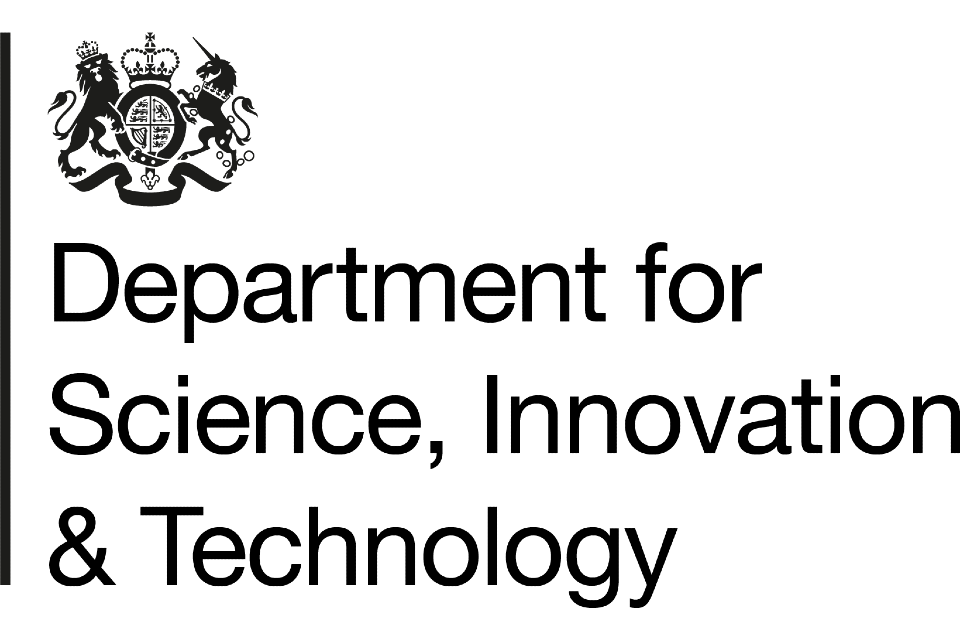



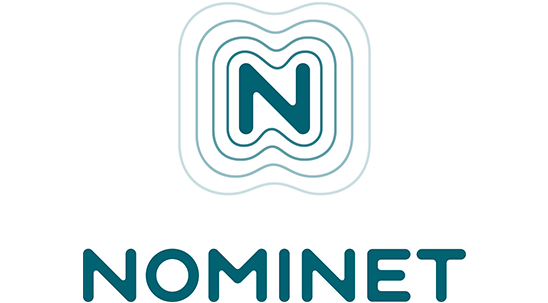
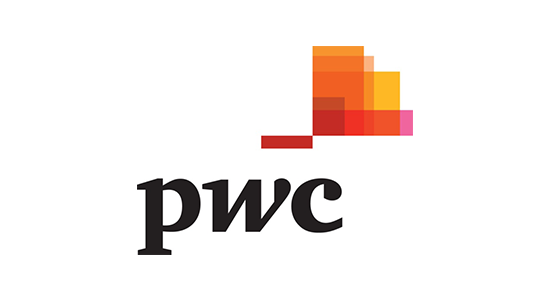

This report is powered by:

With additional thanks to:
.png)
Methodology
To find our more about our methodology, click here.






/Atos.png?width=1200&length=1200&name=Atos.png)
/Bank%20of%20England.png?width=1200&length=1200&name=Bank%20of%20England.png)
/Financial%20Times.png?width=1200&length=1200&name=Financial%20Times.png)
/Hewlett%20and%20Packard.png?width=1200&length=1200&name=Hewlett%20and%20Packard.png)
/Microsoft.png?width=1200&length=1200&name=Microsoft.png)
/National%20Cyber%20Security%20Centre.png?width=1200&length=1200&name=National%20Cyber%20Security%20Centre.png)
/News%20UK.png?width=1200&length=1200&name=News%20UK.png)
/PwC.png?width=1200&length=1200&name=PwC.png)
/Salesforce.png?width=1200&length=1200&name=Salesforce.png)
/Scottish%20Government.png?width=1200&length=1200&name=Scottish%20Government.png)
/Sky.png?width=1200&length=1200&name=Sky.png)
/Zoopla.png?width=1200&length=1200&name=Zoopla.png)


